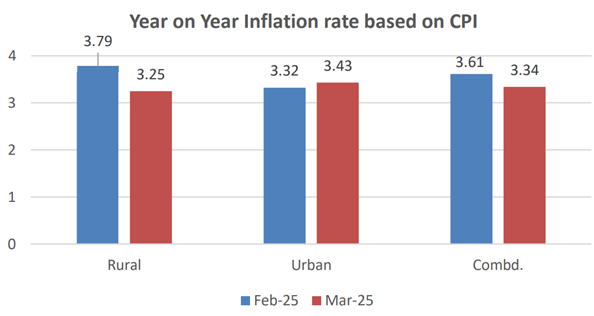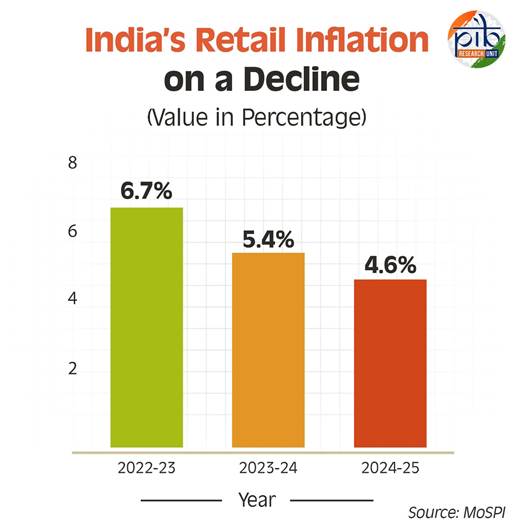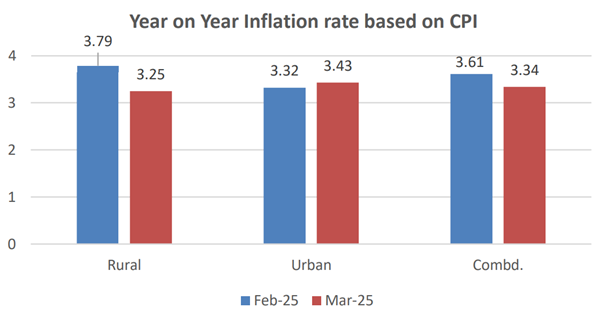#IndiaRetailInflationSixYearLow
2024-25 Retail Inflation Drops to 4.6%, March Sees YoY Dip to 3.34%
New Delhi: Retail inflation in India, as measured by the Consumer Price Index (CPI), which reflects the cost of everyday goods and services, fell to a remarkable 4.6% in the fiscal year 2024-25, the lowest since 2018-19. This milestone highlights the effectiveness of the Reserve Bank of India’s pro-growth monetary policy, which has successfully balanced economic expansion with price stability. Notably, the year-on-year inflation rate for March 2025 dropped to 3.34%, a decline of 27 basis points from February 2025, marking the lowest monthly inflation rate since August 2019. These figures demonstrate a sustained effort to curb price rises while fostering economic growth.

The government’s strategic interventions have been pivotal in achieving this outcome. Key measures include bolstering buffer stocks of essential food items and releasing them periodically in open markets, alongside subsidised retail sales of staples like rice, wheat flour, pulses, and onions. Simplified import duties on critical food items, stricter stock limits to prevent hoarding, and reduced GST rates on essentials have further eased price pressures. Targeted subsidies, such as LPG support under the Pradhan Mantri Ujjwala Yojana and the Pradhan Mantri Garib Kalyan Anna Yojana, have protected vulnerable households from rising food grain costs, ensuring that the benefits of lower inflation reach those who need it most.
What is Consumer Price Index?
The Consumer Price Index (CPI) is one of the most important economic indicators used to measure changes in the general level of retail prices over time. It reflects how much households need to spend on a fixed basket of goods and services they typically consume, such as food, clothing, housing, and fuel. In India, the CPI is compiled by the National Statistical Office (NSO) under the Ministry of Statistics and Programme Implementation (MoSPI) and is currently calculated using the base year 2012. By tracking the cost of this basket over time, the CPI shows how prices rise or fall, affecting the purchasing power of consumers and their overall welfare.
The CPI measures price changes by comparing the current cost of this fixed basket of goods and services to what it cost in a previous period. Since the contents of the basket are kept constant in terms of quantity and quality, any change in the index reflects only the change in prices. When prices increase, the CPI goes up, signalling inflation; when they fall, the CPI declines, indicating lower inflation or deflation.
Originally, CPI figures were developed to track changes in the cost of living for workers so that their wages could be adjusted in line with price movements. Over time, however, the CPI has evolved into a widely used macroeconomic tool. It is now a key benchmark for targeting inflation, monitoring price stability, and guiding monetary policy decisions by the Reserve Bank of India (RBI). It also serves as a deflator in the National Accounts to measure real economic growth.
In India, along with the general CPI (CPI–Combined), segment-specific indices are also published to cater to different population groups:
-
CPI (IW) – Consumer Price Index for Industrial Workers
-
CPI (AL) – Consumer Price Index for Agricultural Labourers
-
CPI (RL) – Consumer Price Index for Rural Labourers
These indices help in wage revisions, rural planning, and understanding inflation trends in specific segments of the population.
Key Highlights for March 2025
-
Food Inflation: The year-on-year food inflation based on the Consumer Food Price Index (CFPI) stood at 2.69% in March 2025, the lowest since November 2021. This marks a sharp decline of 106 basis points from the previous month.
-
Rural food inflation: 2.82%
-
Urban food inflation: 2.48%
-
Drivers of Decline: The overall moderation in food prices was led by a drop in inflation across key categories such as vegetables, eggs, pulses and products, meat and fish, cereals and products, and milk and products.
-
Rural Inflation: A notable fall was recorded in both headline and food inflation in rural areas.
-
Headline inflation fell from 3.79% in February to 3.25% in March
-
Food inflation dropped from 4.06% to 2.82%
-
Urban Inflation: Headline inflation in urban areas saw a marginal rise to 3.43% in March, up from 3.32% in February. However, food inflation declined significantly from 3.15% to 2.48%.
-
Housing Inflation: For the urban sector, housing inflation rose slightly to 3.03% in March 2025 from 2.91% in February.
-
Fuel & Light: Inflation in this category rebounded to 1.48% in March from -1.33% in February, covering both rural and urban areas.
-
Education Inflation: A moderate increase was noted in education-related inflation, rising to 3.98% from 3.83% the previous month.
-
Health Inflation: Prices in the health segment saw a mild rise, with inflation at 4.26% in March, up from 4.12% in February.
-
Transport & Communication: Inflation in this category increased to 3.30% in March 2025 compared to 2.93% in February.
-
Items with Highest Inflation: In March 2025, the top five items with the highest year-on-year inflation were coconut oil (56.81%), coconut (42.05%), gold (34.09%), silver (31.57%), and grapes (25.55%).
-
Items with Lowest Inflation: The items witnessing the steepest decline in prices were ginger (-38.11%), tomato (-34.96%), cauliflower (-25.99%), jeera (-25.86%), and garlic (-25.22%).
Retail Inflation Eases for Third Year in a Row
Retail inflation in India has followed a steady downward path over the past three financial years, falling from 6.7 percent in 2022–23 to 5.4 percent in 2023–24, and further to 4.6 percent in 2024–25. This consistent moderation highlights the combined impact of the Reserve Bank of India’s calibrated monetary policy and the Government of India’s focused interventions to ease supply-side constraints and stabilise prices of essential commodities. The declining trend has helped ease cost-of-living pressures and fostered a more stable environment for economic growth.

From High Prices to Stability: A Decade of Inflation Control
Between 2009–10 and 2013–14, India faced a prolonged period of high inflation, with the average annual rate remaining in double digits. Households across the country bore the brunt of steep increases in food and fuel prices, which eroded purchasing power and created a challenging environment for both consumers and businesses. Looking at a broader timeframe, the average annual inflation between 2004–05 and 2013–14 stood at 8.2 percent, reflecting a decade marked by considerable volatility in retail prices.
Post Views: 27



